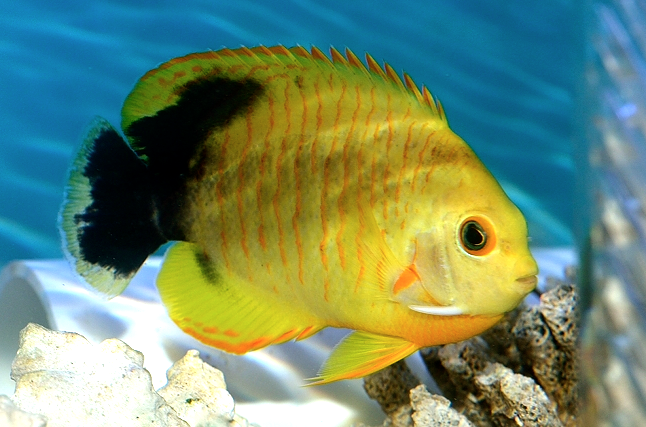Crosses between Centropyge flavissima and Centropyge eibli so spectacular and are simply one of the most beautifully created natural hybrids that a nickname has been coined just for them – Tigerpyge. The tigerpyges are usually collected in the Indian Ocean where the blue eyed IO lemonpeels hybridize with the eibl’s angelfish. The specimen above at first glance may come off as a stunning hybrid but it is in fact, a cleverly disguised impostor.

Singapore’s mega LFS Coral Farm secured this mesmerizing angelfish from Indonesia, and it measures in at slightly more than 3 inches – just about as large as they can get. What’s unique about this particular individual is that the traits of C. eibli are almost fully intact, with hardly any dilution in the black pattern at the back. In most Tigerpyges, the characteristic black markings of the Eibl’s Angelfish is reduced to only the tail. In some specimens, an almost complete lack of black pigmentation is observed.

On top of that, the fish possesses some fuliginous black dusting over the body as well as a disorganized smokey pattern on the tail. Such markings are almost always observed in large aberrant Centropyge such as the “Photoshop” coral beauty and Jimmy’s Koi coral beauty.

The intense yellow coloration is not likely due to genetic input from the lemonpeel angelfish, but more likely a result of a xanthic aberration. Fish that display xanthic aberrations are usually very yellow throughout and do not retain this coloration in captivity. Weeks or months down the road, the fish will slowly revert back to their normal coloration. Much like other aberrations, no one really knows why these fish are colored like this in the first place, or why they are unable to retain such coloration in captivity.

Our xanthic Eibl’s Angelfish also possess a pair of normal colored eyes, unlike their hybrid counterparts. A quick search on the past Tigerpyges that appear in the trade reveals that almost all of them possess blue irises, a trait that has been passed on by the blue eyed lemonpeel angelfish from the Indian Ocean. It makes sense, since most of the collected hybrids come from the Indian Ocean where the blue eyed lemonpeels occur. This particular one however, does not possess blue irises. The fact that it was collected in Indonesia reduces the probability of hybridization with the Indian Ocean lemonpeel – although this is not entirely impossible, as blue eyed tigerpyges have been collected from Indonesia before, suggesting that it is possible for Indian Ocean lemonpeels to waif over.

Lacking the blue iris, it is unlikely that this Eibl’s Angelfish had any genetic input at all from the Indian Ocean lemonpeel. Discerning the identity of fishes based on appearance from the flavissima complex is very tough, especially when it comes to hybrids and aberrant individuals. These fishes are so closely related that their DNA are practically identical. Dr. Luiz Rocha just published a fantastic paper on the phylogenetics and differentiation between the lemonpeel variants and their closely related sibling species and the results are very interesting.
We have no idea if this fish will retain its coloration for certain but based on countess xanthic fish encountered in the past, it is very likely that this fish will change back into a run of the mill Eibl’s Angelfish in a short time. It could however, turn out to be another freak fish like Jimmy’s coral beauty, and decide to remain as an aberrant. Again, the mechanism for aberration and why the color form is so unstable is still not clear. It is strange when you think of it at a genetic level. These aberrations are so transient that they may take anywhere from a few days, weeks, even months to revert back to standard color. Do certain genes switch on and off under certain stimuli that result in a particular color morph, and are all fish capable of expressing aberrant coloration? Also we’ve noticed that these funky distorted aberrations are almost always found in large sized specimens. Hardly any juveniles or smaller sized fish are found with these colors.
If someone really has an answer to this, it will really be fascinating to learn how aberration works in the coloration of marine fish species. It is a mere coincidence that this particular Eibl’s Angelfish decided to look like a Tigerpyge and confuse us all, but we’ll know for sure in a few weeks if it really is an aberrant. There could still be a chance that this is indeed a Tigerpyge. Again this group of fishes are confusing and have a ton of tricks up their sleeves. We won’t be surprised but for now, we await with baited breaths, the final appearance of this fish in the future.





